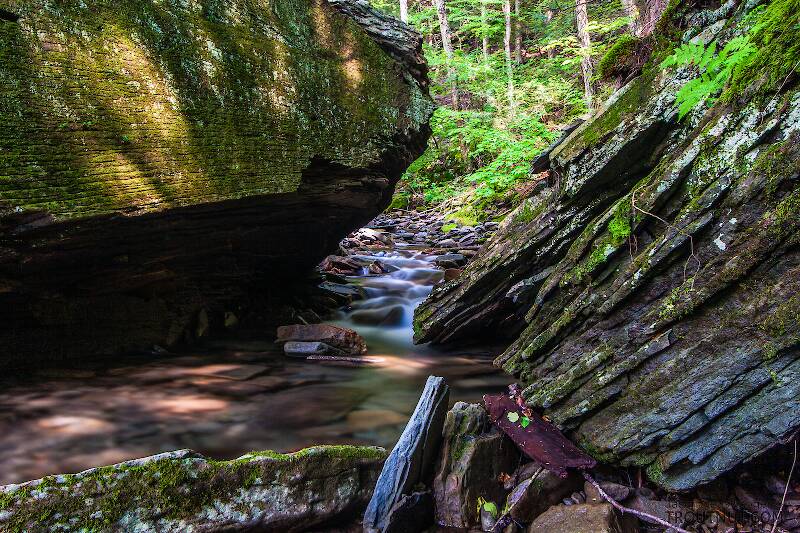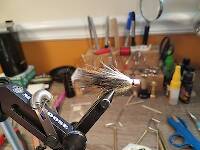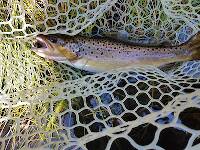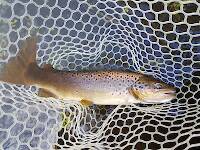
Blue-winged Olives
Baetis
Tiny Baetis mayflies are perhaps the most commonly encountered and imitated by anglers on all American trout streams due to their great abundance, widespread distribution, and trout-friendly emergence habits.
Featured on the forum

Troutnut is a project started in 2003 by salmonid ecologist Jason "Troutnut" Neuswanger to help anglers and
fly tyers unabashedly embrace the entomological side of the sport. Learn more about Troutnut or
support the project for an enhanced experience here.
JAD on Jul 20, 2007July 20th, 2007, 6:54 am EDT
The other day i was talking to Louis about some extraordinary fishing I had in the bright sunlight. Well I was reading Ray Bergman book Trout , and Ray said that colors change in sunlight and fishing in harder in early morning and evening.
That got me thinking ( scary huh) I thought if we got Rocky And John W and the rest of this crew to discussing (You to Louis) color and Trout eye sight----------might make for some interesting discussion.
Since I'll be at the shore next week, and my mind will be on beer and suntanned women I will look forward to reading large volumes of imfo.I figure long winded Rocky will be good for at least fifteen minutes or five pages----which ever comes first. (Stir stir)
See everybody next week.
JaD (Caddisman)
They fasten red (crimson red) wool around a hook, and fix onto the wool two feathers which grow under a cock’s wattles, and which in colour are like wax.
Radcliffe's Fishing from the Earliest Times,
GONZO on Jul 20, 2007July 20th, 2007, 10:59 am EDT
John,
Bergman may simply have been referring to the difficulty of discerning color when a dry fly is backlit. (I'd have to go back and check.) Under lower angles of light, the color of a surface offering can be easier to see, sometimes allowing for greater discretion on the trout's part. That would be kind of a funny observation for Bergman, though, given that he really didn't believe in imitation.
Also, trout lack the ability to dilate or constrict their pupils, probably one reason that they often favor the shadows. Really, I wanted to direct you to an older discussion of trout vision, but I can't locate it. That's a shame, because David (DMM) had offered some really good information in that lost thread.
As for the "long-winded Rocky" comment, I'm forced to identify with the first part of that epithet, but "Rocky" is my dad's nickname. That confusion probably came from the header on an email message. Sorry I couldn't offer the five pages or fifteen minutes you wanted--you'll just have to stir harder. Enjoy the beer and the bathing beauties!
Bergman may simply have been referring to the difficulty of discerning color when a dry fly is backlit. (I'd have to go back and check.) Under lower angles of light, the color of a surface offering can be easier to see, sometimes allowing for greater discretion on the trout's part. That would be kind of a funny observation for Bergman, though, given that he really didn't believe in imitation.
Also, trout lack the ability to dilate or constrict their pupils, probably one reason that they often favor the shadows. Really, I wanted to direct you to an older discussion of trout vision, but I can't locate it. That's a shame, because David (DMM) had offered some really good information in that lost thread.
As for the "long-winded Rocky" comment, I'm forced to identify with the first part of that epithet, but "Rocky" is my dad's nickname. That confusion probably came from the header on an email message. Sorry I couldn't offer the five pages or fifteen minutes you wanted--you'll just have to stir harder. Enjoy the beer and the bathing beauties!
JOHNW on Jul 20, 2007July 20th, 2007, 3:14 pm EDT
Consider the bait taken but I'll need to ruminate on it for a spell.
I will submit that theoretically there is more of the visable spectrum available with bright light so I can understand where Bergman may have been coming from.
Ozzie Ozafovich also has some great footage that highlights Gonzo's first point.
JW
I will submit that theoretically there is more of the visable spectrum available with bright light so I can understand where Bergman may have been coming from.
Ozzie Ozafovich also has some great footage that highlights Gonzo's first point.
JW
"old habits are hard to kill once you have gray in your beard" -Old Red Barn
Konchu on Jul 21, 2007July 21st, 2007, 11:34 am EDT
See the "Bass Bugs" thread for discussion of fish vision
GONZO on Jul 22, 2007July 22nd, 2007, 4:11 pm EDT
John,
Thanks to Jason pointing out what should have been obvious to me (the search function--DUH!), I can now point you to that previous discussion of trout vision. It's under "Bug Bellies II" in the photography section. (Of all places . . . !)
Thanks to Jason pointing out what should have been obvious to me (the search function--DUH!), I can now point you to that previous discussion of trout vision. It's under "Bug Bellies II" in the photography section. (Of all places . . . !)
JOHNW on Jul 23, 2007July 23rd, 2007, 12:56 pm EDT
Rumminant is now ready for regurritation to an upper chamber.
I think we are actually looking at two different issues.
One is the interplay of light and colour, or perhaps more precisely stated "on colour" (yes I'm feeling a little tweedy with my spelling). The second is time of day one is fishing.
While the two are related I think there is not a specific causitive relationship.
As a general conscenous morning and evening fishing is "easier" due to low light conditions. I believe this has become an axiom because said lighting conditions hide mistakes made by the angler in approach or presentation and has little to do with how well the fish actually see the fly.
Conversely I would suspect that fishing during the bright of the day magnifies such errors however also makes patterns more prominent by the sharp contrast created by a prominently backlight fly.
The question of color I believe is actually somewhat minor in the grand scheme as compared to approach and presentation.
JW
P.S. Hope that was coherent as I'm still on tilt from a thread on a different forum.
I think we are actually looking at two different issues.
One is the interplay of light and colour, or perhaps more precisely stated "on colour" (yes I'm feeling a little tweedy with my spelling). The second is time of day one is fishing.
While the two are related I think there is not a specific causitive relationship.
As a general conscenous morning and evening fishing is "easier" due to low light conditions. I believe this has become an axiom because said lighting conditions hide mistakes made by the angler in approach or presentation and has little to do with how well the fish actually see the fly.
Conversely I would suspect that fishing during the bright of the day magnifies such errors however also makes patterns more prominent by the sharp contrast created by a prominently backlight fly.
The question of color I believe is actually somewhat minor in the grand scheme as compared to approach and presentation.
JW
P.S. Hope that was coherent as I'm still on tilt from a thread on a different forum.
"old habits are hard to kill once you have gray in your beard" -Old Red Barn
Konchu on Jul 23, 2007July 23rd, 2007, 1:09 pm EDT
ya, you're coherent JOHNW. thanks for sorting out the two vision discussions.
GONZO on Jul 23, 2007July 23rd, 2007, 2:34 pm EDT
Ray Bergman:
JohnW:
John, Ray, touch gloves and come out swinging! :)
(Actually, there are two different perspectives here--the trout's ability to discern vs. approach/presentation--and both John and Ray have made valid points. I would only point out a third perspective suggested by Bergman's "if" statement--when trout feed can easily be as significant as either of the other observations. Of course, you'll have to read the rest of Bergman's commentary to appreciate his perspective.)
Trout are selective to color and shape in inverse ratio to the intensity of light. In other words trout are more selective in the early morning and in the evening and on dark days than they are when the sun is shining brightly on the water. For this reason, if the trout will feed at all during the middle of the day, then a bright day will be the best sort of day on which to fool them.
JohnW:
As a general conscenous morning and evening fishing is "easier" due to low light conditions. I believe this has become an axiom because said lighting conditions hide mistakes made by the angler in approach and presentation and has little to do with how well the fish actually see the fly.
John, Ray, touch gloves and come out swinging! :)
(Actually, there are two different perspectives here--the trout's ability to discern vs. approach/presentation--and both John and Ray have made valid points. I would only point out a third perspective suggested by Bergman's "if" statement--when trout feed can easily be as significant as either of the other observations. Of course, you'll have to read the rest of Bergman's commentary to appreciate his perspective.)
Quick Reply
Related Discussions
Topic
Replies
Last Reply
Re: My wild and crazy trip to Florida & back, part 2: fly fishing & bottom bouncing 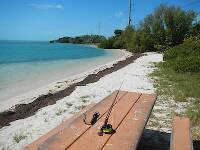

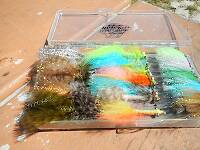
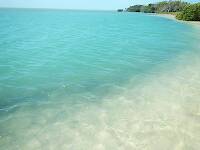
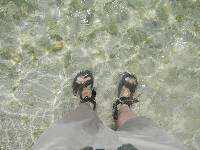
In the Photography Board by Jmd123
+ 15





In the Photography Board by Jmd123
1
Mar 16, 2020
by Martinlf
by Martinlf

